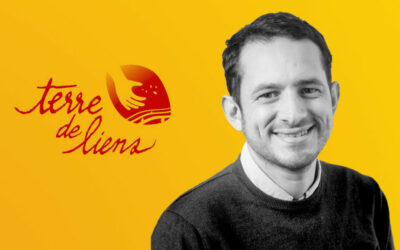Discover How Holacracy Is Influencing and Inspiring Managers in the Grenoble Metropolis. Hélène Clot, Director of Strategy, Innovation, and Citizen Relations, shares her journey and how Holacracy is addressing key challenges in the public sector today. She explains how this approach has transformed her management style and collaboration with her team.
How would you introduce yourself?
I can start with my role within the Metropolis! I am the Director of Strategy, Innovation, and Citizen Relations. This department includes three teams, totaling around thirty people, working on policy planning, evaluation, innovation, citizen participation, and metropolitan user relations.
We operate at the intersection of public policy—which directly impacts local residents—and internal organizational development. Our team serves as a resource function, supporting the transformation of public service delivery—from policy design to its practical implementation within the organization.
How did you come across Holacracy?
In my previous team, we collectively decided to experiment with horizontal management. Our hierarchical manager had little time for us and encouraged us to self-organize, which worked well because we were all highly autonomous. I was convinced by this approach—until I realized that no one was actively taking care of the team as a whole, particularly those who were struggling. Eventually, I recognized the need for a leadership role, someone to support and sustain the group. Later, when I took on a management position, I asked myself: What kind of leadership do I want to cultivate within my team? I was already familiar with Sociocracy, but with Holacracy, I found the structured methodology I needed.
How has Holacracy changed your management style?
One major advantage is clarifying the different roles I play. Just like any other team member, I can bring up my tensions and benefit from feedback and support from other roles in the team. For example, I have a dual hierarchical attachment—both technical and political. Explicitly defining my roles as a liaison with the executive committee and a dialogue facilitator with elected officials helps me identify specific tensions and bring them to tactical meetings in my circle. This makes my work visible beyond just leading meetings and assigning roles.
I can now adopt a different stance: I am no longer just the one providing solutions—I can also bring my own challenges to the table! Another key shift with Holacracy is empowering my team. Instead of them relying on me for solutions, we find answers together. We even ask ourselves: What is stopping you from making this decision? Do you need advice? My role shifts from decision-maker to decision partner.
We use Holaspirit to track roles and projects. For example, it has been helpful during annual reviews, allowing me to quickly assess each team member’s roles and ongoing projects.
Gradually, this approach has also made my synthesis role more manageable. I no longer feel like I must have all the answers when questioned by higher-ups. With Holaspirit, I can easily access tactical meeting reports for sessions I didn’t attend. This greatly improves delegation.
For more on tactical meetings, I recommend reading the article: “Tactical Meetings: Operational and Effective.”
How does Holacracy align with the general management’s expectations?
The executive committee has a clear directive:
Improve management quality by fostering cross-functional collaboration and efficiency.
Efficiency is primarily about: Faster decision-making, Clarifying meeting participation—who should attend which discussions?
Cross-functionality is about enhancing cooperation, and Holacracy directly supports these delegation and collaboration skills.
Based on our team’s experience, we proposed that the executive committee draw inspiration from Holacracy. Several teams have since received training, and tactical meetings are now widely adopted among colleagues.
What aspects of Holacracy naturally fit your organization?
Several things!
For example, helping different teams work in project mode or clarifying the interface between two departments. Our team is often asked to advise internally on these matters. We use Holacracy principles to structure our approach:
- What is the purpose of each role?
- Are these purposes well-defined, clear, and complementary?
- Are there domains that require explicit communication before someone takes action?
- What are the responsibilities of each role?
- What can colleagues expect from one another?
- This perspective is extremely useful and provides concrete solutions.
How has Holacracy influenced cross-functional collaboration in the Metropolis?
We’ve created “transversality circles” to tackle issues outside the official competencies of the Metropolis. These topics aren’t strictly within the jurisdiction of any one department, so no single service was responsible. This previously led to:
- Confusion,
- Duplication of efforts, or
- Major gaps in accountability.
We proposed that all circles be led by a facilitator/scribe duo, following the tactical meeting format.
This has helped with:
- Biodiversity initiatives
- Youth-related programs
- University relations
- Urban planning agency coordination
- Facilitators and scribes play a crucial role in ensuring that transversality is real and effective.
A member of the executive committee acts as a sponsor within these circles, ensuring alignment with leadership. The circles define specific domains, giving them a cross-functional view of the Metropolis’ actions, contracts, and initiatives. This strengthens internal networks, fosters cooperation, and helps consolidate best practices. Moreover, these circles are now recognized externally, improving the Metropolis’ relationships with partners.
What is the next step in integrating Holacracy?
Recently, I realized that our circles’ strategies need to be more explicit.
Elected officials define public policy priorities, and the executive committee sets work priorities through management dialogues. While we are aware of these priorities, they aren’t formally recorded within our circles.
This realization underscores how Holacracy is fully compatible with the hierarchical structure of our public administration.

Juliette Brunerie
Discover other articles written by the author!
Other articles .
Interview with Fabio Monte, leader of QoQa: Holacracy with a team of 180 people, an ambitious challenge
Interview with Fabio Monte, Leader at QoQa QoQa is one of the biggest players in the Swiss e-commerce market. The idea for this platform was launched in 2005 by its founder, Pascal Meyer. The concept is simple: handpicked products available for just 24 hours at...
How QoQa Managed to Successfully Implement Holacracy Using Holaspirit
Read the articleDiscover other articles written by the author!Other articles .
What does Holacracy enable in a co-directed organization? Interview with Hugo, co-director of the Terre de Liens Foundation
Hugo Arnaud, you are the Co-Director of the Foundation. Can you tell us more about your background? I joined Terre de Liens a year and a half ago and am now Co-General Director following the departure of the founder. I studied business and have always been passionate...




